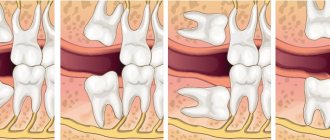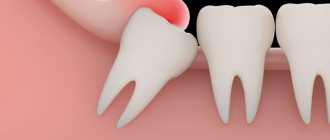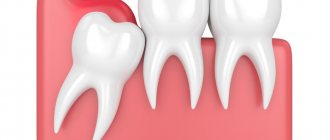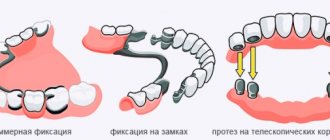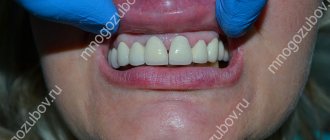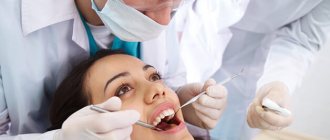The jaw of modern man is smaller than that of his ancient ancestor. This difference is 10-12 mm. The reason for the reduction of the jaw is a change in the nutritional pattern of living people. Food has become softer, carefully processed chemically or thermally. Therefore, the need for a large and powerful jaw disappeared. Wisdom teeth, which are located outermost in the dentition, have thus lost their practical use and become rudiments. Eights usually grow up later than others - between 14 and 25 years of age or later. Hence the wisdom-related name for the third molars, as dentists call them.
Every person has two rudiments of “eights” on the upper and lower jaw, but often there is not enough space for all the rudimentary teeth, and they cause a lot of problems. Wisdom teeth often fully erupt and not all become aligned. The figure eight may remain impacted, that is, hidden under the gum or bone, or may only partially erupt. The formation of third molars takes a long time. The growth of wisdom teeth can take years. Periods of growth usually alternate with phases of rest and development.
Unlike other teeth, eights do not have milk predecessors. In addition, it is very inconvenient to fully clean them due to their extremely difficult to reach position. All this leads to the development of pathological processes and difficulties during periods of their growth. Removing wisdom teeth is also considered a complex procedure with a high degree of trauma. The most common complaints that patients come to dentists with are swelling, inflammation and soreness of the gums near the “eight”. The causes of these uncomfortable phenomena are caries, pericoronitis, difficulties in the germination and eruption of wisdom teeth, as well as deep infectious and inflammatory processes in the root area and nearby tissues.
Painful eruption and incorrect position during germination
Periods of active wisdom teeth eruption often cause discomfort. Many people experience pain during this process, swelling and inflammation of the gum tissue. The reason for this manifestation is the absence of the previous milk tooth in the place where the figure eight grew. Third molars are forced to find a path of growth and break through dense bone tissue, which, given the large size of these teeth, becomes the cause of discomfort. Often, the lack of space for the normal position of the figure eight leads to its complicated germination.
In particularly difficult cases, the tooth takes on a dystopic position. It grows in an atypical direction, not upward, but at an angle. It causes injury to neighboring teeth and displacement of the entire dentition, up to bite deformation. A wisdom tooth growing horizontally can injure the cheek, tongue and roots of its “neighbors”.
My gums hurt after filling a tooth, what should I do?
If, after installing a filling, your gums are very sore and even your cheek is swollen, you cannot do without the help of a dentist. Moreover, it is necessary to contact as soon as possible so that there are no even more unpleasant consequences.
A few tips to relieve pain:
- applying an ice compress to the cheek at the sore spot for several minutes or a compress with ice cubes;
- alternate application of compresses with warm rinses from decoctions of medicinal herbs or infusions;
- painkillers;
- balms to strengthen teeth and gums.
Attention! Under no circumstances should you apply hot or warm compresses - they actively provoke inflammation and pain!
Taking antibiotics without a doctor's prescription is also extremely contraindicated, because this can lead to a decrease in immunity and complicate further treatment.
Preventive measures
After filling a tooth, during the first week, you must strictly follow the main rules so that pain does not occur, or it disappears as soon as possible:
- do not drink or eat too cold or too hot, as temperature changes provoke pain;
- every time after eating, brush your teeth and rinse your mouth with special anesthetic rinses (the ASEPTA series includes rinses with an analgesic and disinfecting effect);
- try to eat softer foods so as not to damage the periodontal tissues, and it is preferable to chew only on the healthy side;
- do not smoke, as the tooth disturbed by treatment is very sensitive in the first days.
How does pericoronitis occur?
If a wisdom tooth grows for a very long time or grows atypically, then partial gum loss above the surface of the tooth may occur. This creates a gum hood over the figure eight. This formed hood contains food debris that is very difficult to remove. They cause the proliferation of pathogenic bacteria, which ultimately leads to pericoronitis. In addition, if there is an upper double figure eight, then the gingival hood is constantly injured when biting, which becomes the cause of a non-infectious inflammatory process in the gum tissue. Pericoronitis can be acute (purulent or catarrhal) or chronic. Signs of pericoronitis:
- acute pain radiating to the neck or ear;
- soreness of the gum tissue during palpation and chewing;
- inability to open your mouth;
- purulent discharge;
- swelling of the mucous membrane;
- specific odor from the mouth;
- temperature increase;
- enlargement of the submandibular lymph nodes.
If the disease has taken a chronic form, then you will not have to wait long for noticeable painful manifestations. Pericoronitis regularly recurs with all the symptoms of an acute purulent form. Complications of untreated pericoronitis can be periostitis, abscess, osteomyelitis of the jaw or phlegmon. Therefore, if signs of pericoronitis are detected, urgent dental care is needed. The specialist, taking into account the phase and form of the disease, will select the appropriate treatment. Medication or surgery may be needed.
Causes of pain in the gums
Unpleasant sensations in soft tissues can be temporary or permanent. Most often pain occurs:
- due to damage to the gums by hard food, bone, toothpick,
- using a toothbrush with stiff bristles,
- untimely removal of soft plaque,
- consuming hot foods and drinks,
- allergies to mouthwash components,
- deficiency of vitamins and minerals in the body.
When the mucous membrane is injured, the pain goes away within 2-4 days. Also, sometimes it is enough to change the brush to a softer one, buy another toothpaste and rinse to get rid of discomfort in the oral cavity.
Infectious and inflammatory processes, caries
The hygiene of wisdom teeth is complicated by their inaccessibility, so they are prone to various dental diseases. Due to incomplete eruption, specific structure and prolonged germination, eights are predisposed to various painful conditions:
- Caries is a common disease that also occurs in impacted eights. Very often, wisdom teeth erupt with signs of crown destruction, even if they have been under the gum tissue for a long time.
- Complications of caries - periodontal cyst, pulpitis, periodontitis.
- Acute purulent-inflammatory processes - fistula, flux and abscess.
general characteristics
The pain is caused by changes in the gums and periodontium, which occur under the influence of local factors: poor oral hygiene, the presence of tartar, functional periodontal insufficiency due to a decrease in chewing load when eating too soft food.
Smoking plays a significant role. Common factors affecting the condition of oral tissues are gastrointestinal diseases, infectious and endocrine pathologies, natural changes in hormone levels, and harmful occupational exposures. The listed reasons entail the formation of an environment favorable for the activity of pathogenic microorganisms, the development of inflammation, disruption of the local blood supply and nutrition of the gums, and changes in its structure. The result is a pain syndrome. Often the periodontium is involved in the pathological process, the disease becomes chronic, leading to gross local changes and tooth loss.
First aid
Before going to the dentist, you can relieve pain at home using certain pharmaceutical products.
- Drink a painkiller drug - Nimid, Nice, Analgin, Ketanov, Paracetamol, Tempalgin.
- Place the turunda on the swollen area with a special ointment or gel - Kamistad, Dentinox, Metrogyl-Denta, Cholisal.
- Rinse the mouth with antiseptic solutions - Miramistin, Chlorhexidine and Furacilin.
You can use home help methods for three days. Next, the supervision of a professional doctor is necessary. If the pain does not go away and the swelling does not go away, then you should immediately visit a dentist to find out and eliminate the cause of the painful condition. Inflammation during pericoronaritis is relieved by washing the gingival hood with pharmaceutical antiseptic solutions: Iodopharm, Potassium permanganate, Furacilin.
Also popular among rinses are:
- Hydrogen peroxide solutions, chlorhexidine;
- Infusion of nut leaves;
- Decoctions of sage, oak, chamomile;
- Black radish juice mixed with honey;
- Propolis tincture (20 drops per glass of water is enough)
- Shilajit infusion (3 g of raw material per half glass of water).
The downside of herbal rinses is the darkening of tooth enamel due to the settling of dyes on it.
Important! You should not rinse intensively after tooth extraction because you may rinse out the clot that has formed in the hole!
Therapeutic applications on the gums can be made from:
- Fresh aloe leaf, separating juice;
- Grated raw potatoes;
- A cotton pad soaked in sea buckthorn oil.
As you can see, the methods are quite original, but you can turn to them if you don’t have medications at hand such as gels “Cholisal”, “Metrogil-Denta”, “Parodontsid”, etc. These drugs (especially “Cholisal”) help reduce swelling, stop inflammation and pacify pain. Gels such as “Kalgel” and “Kamistad” do not have a pronounced anti-inflammatory effect, but contain an anesthetic that will numb the mucous membrane for a while.
Traditional medicine methods
Folk remedies can be auxiliary methods for eliminating inflammation in the early stages. At the initial stages they are able to give excellent results. There are herbs, decoctions and infusions of which can have anti-inflammatory, disinfectant, wound healing and antimicrobial effects. To get such a decoction, you need to pour a teaspoon of beneficial herbs with a glass of boiling water and let it brew. Next, the resulting substance is filtered and the inflamed area is rinsed 4-6 times a day. Healing plants in this situation are chamomile, lemon balm, oak bark, calendula, sage and St. John's wort. A weak soda-salt solution can also have an anti-inflammatory effect. You need to rinse your mouth with it three to five times a day.
Consumer Reviews
Mrs. Doubtfire about Asepta Active mouth rinse (irecommend.ru):
“When I was faced with a serious gum problem, this rinse was recommended to me by a dental surgeon.
Asepta Active mouthwash is a medical product and is sold only through the pharmacy chain. The instructions recommend taking breaks in use. Personally, I use it in courses and during exacerbations of gum inflammation. I've been using it for about 2 years.
The mouthwash is minty, pleasant, slightly astringent. Improvement is felt from the first use. Bottle volume 150 ml. Manufacturer: Russia, St. Petersburg. A convenient measuring cup is included.
You can (better) buy it as a set, which also includes balm and toothpaste, which comes as a gift.
I’m very happy that such products from a domestic manufacturer have appeared!”
julia-06 about Asepta Active mouth rinse (irecommend.ru):
“A very good rinse for problem gums.
She had never encountered the problem of bleeding gums, but at her next visit to the dentist she noticed that when she only lightly touched her gums, they began to bleed. So the dentist gave me a mini version of Paradontax toothpaste and advised me to use a mouthwash after brushing my teeth. Mom bought Asepta active mouth rinse.
For some reason I used to be very skeptical about such remedies, but as it turned out, in practice it helps very well. My problem went away completely, my gums stopped bleeding. I don’t even want to read the ingredients and go into its details, it’s unlikely that everything is super natural, but since it helps, I give the mouthwash a solid 5 points. Of course, each case is individual, but I will recommend it based on my experience. And the price of the rinse aid is quite reasonable.”
Specialist help
In case of inflammation of the gingival tissues around the eights, the best solution is to immediately visit a dentist. The specialist will conduct an x-ray and a visual examination of the condition of the tooth and the surrounding area. Based on the examination results, competent treatment will be prescribed:
- Medication - by prescribing antihistamines and anti-inflammatory drugs, antibiotics, special ointments and gels, antiseptic baths.
- Surgical - cutting the gum or gingival hood, removing the figure eight that caused the problem.
If inflammation is accompanied by unbearable acute pain and severe swelling of the gums, a specialist performs a novocaine blockade. Sometimes laser therapy is prescribed, which has an anti-inflammatory effect on the affected area.
Diagnostics
A dentist will determine the cause of pain in the gums. A dental examination involves assessing oral hygiene, studying the condition of soft tissues, identifying signs of inflammation and mucosal defects, determining the presence and severity of periodontal pockets and tooth mobility. As part of the additional examination, the following procedures are prescribed:
- Radiography.
In inflammatory periodontal diseases, osteoporosis is visible in the photographs. Horizontal destruction indicates a chronic course of the pathology, vertical destruction indicates the formation of abscesses. With periodontal disease, osteoporosis is combined with sclerotic changes. Based on the results of radiovisiography or orthopantomography, the type and severity of malocclusion is assessed. - Bacteriological or bacterioscopic examination
. Performed for Vincent's stomatitis and inflammatory periodontal diseases. This type of stomatitis is characterized by a large number of Borrelia Vincent. In other cases, various types of pathogenic bacteria are found, less often fungi. - Other laboratory tests
. The inflammatory process is accompanied by leukocytosis and an increase in ESR in the general blood test. If an allergy is suspected, intradermal, scarification, cutaneous drip, exposure and elimination allergy tests are performed.
Dental examination
Help with inflammation after removal
Due to their inaccessible location, full or partial impaction, and large tooth sizes, removal of third molars is often painful and traumatic. If after surgery to remove figure eights there is severe swelling, and it is accompanied by increasing pain for more than three days, this may be a sign of a disease called alveolitis. It occurs due to the entry of bone fragments, pathogenic bacteria into the wound formed after extraction, or due to the blood clot being washed out of the hole too quickly.
Signs of alveolitis are sharp pain in the wound area, redness of the gums, swelling of the extraction site, absence of a blood clot in the first week after the removal procedure, purulent discharge, fever, enlarged submandibular lymph nodes, general weakness.
It is very important to treat alveolitis immediately. This condition, without proper help, can cause tissue necrosis, abscess, phlegmon and osteomyelitis. In addition, alveolitis can lead to blood poisoning. If there are any signs of this problem, an urgent visit to the dentist is indicated.
Swelling of the gum tissue around the wisdom tooth is the first signal about the development of complex and dangerous dental diseases. Therefore, it is important not to rely on self-medication, but to consult a specialist in time.
If the gums are swollen due to periodontitis -
No less often, complaints that the gums around the tooth are swollen are associated with the patient having an inflammatory gum disease, which is called periodontitis. With periodontitis, there is destruction of the attachment of the gingival margin to the necks of the teeth, destruction of the bone tissue around the teeth, as well as periodontal fibers, due to which the tooth is attached to the bone tissue. As a result of these processes, periodontal pockets are formed between the gum and tooth (Fig. 14).
There are a lot of pathogenic bacteria in such pockets, and therefore serous-purulent exudate is always released from them. When the pocket becomes deep enough (more than 4 mm), the drainage of exudate from the gum pocket may be disrupted, which leads to the formation of a purulent abscess in the depths of the pocket. Dentists usually use the term periodontal abscess in this case (Fig. 15-16).
Swelling of the gums in the projection of the periodontal pocket –
Why gums swell during periodontitis: reasons
Periodontitis can be local and generalized. Local periodontitis differs in that it occurs only in one or several teeth exposed to a traumatic factor. For example, the formation of a periodontal pocket can be caused by trauma to the gums due to the overhanging edge of a filling in the interdental space, or by an incorrectly made crown or removable denture. Also very often the cause is traumatic occlusion, when some teeth are subjected to increased chewing load (for example, due to the loss of part of the chewing teeth).
If the teeth that have swelling on the gums do not have fillings or crowns, and you do not have long-term chronic inflammation of the gums, then you can immediately say that the reason is the presence of premature closure of the teeth in this area of the dentition. As a result, an increased mechanical load is placed on the tooth, which leads to the onset of destruction of the bone around the tooth and the formation of a periodontal pocket (24stoma.ru).
But in chronic generalized periodontitis, the causes of gum swelling are completely different. You can immediately suspect this form of periodontitis if you periodically experience bleeding when brushing your teeth, there is constant low-grade inflammation of the gingival margin in the area of all teeth (which is accompanied by swelling of the gingival papillae, their redness or cyanosis). The cause of this form of periodontitis is the accumulation of soft microbial plaque on the teeth, as well as hard dental deposits.
Microbial plaque and tartar bacteria produce toxins that destroy the dental-gingival attachment and bone tissue around the teeth, and also destroy the periodontal attachment of the tooth to the bone. With this form of periodontitis, periodontal pockets can be found in almost all teeth, and not 1-2 teeth as in the local form of periodontitis. When the discharge of serous-purulent discharge in one of the pockets is disrupted, a periodontal abscess is formed in the projection of the pocket.
Symptoms - if periodontitis, swelling of the gums occurs mainly in the projection of the apex of the tooth root or the bone interradicular septum, then with periodontitis the gums always swell in the projection of the formed periodontal pocket. Sometimes you may notice that thick pus spontaneously secretes from under the gums in the area of swelling, or it may appear when you gently press on the swelling (such symptoms clearly indicate that the cause is periodontitis, not periodontitis).
Also, the fact that the cause was local or generalized periodontitis can be indicated by the presence of mobility of the causative tooth, especially if mobility was present even before the swelling appeared. Let's now figure out what to do if the gums are swollen due to periodontitis... Treatment of the local and generalized forms of this disease will differ, because their development is caused by various reasons.
Treatment of local periodontitis –
When you see a doctor, the doctor, based on an examination and analysis of an x-ray, will determine the presence of a periodontal abscess and the amount of tissue destruction around the tooth (the depth of the periodontal pocket). Treatment immediately begins with eliminating the traumatic factor - removing the overhanging edge of the filling, grinding the contacts on the chewing surface of the causative tooth. At the same time, under anesthesia, the periodontal abscess is opened to allow the pus to drain out.
Next, the pocket is washed with antiseptics, systemic antibiotic therapy is prescribed, as well as a home course of anti-inflammatory therapy, consisting of antiseptic rinses and treatment of the gums with an anti-inflammatory gel. At the same time, the issue of the need to depulpate the tooth can be resolved, i.e. removal of the nerve and filling of the root canals (this is necessary if the depth of the periodontal pocket reaches more than 1/2 the length of the tooth root).
Removal of the nerve in such a situation is required because infection from a deep pocket can penetrate through the bloodstream into the tooth pulp (through the apexes of the roots). And then in this case, the tooth pulp itself becomes a source of infection. But this is all just basic treatment! The main treatment will be an open curettage operation of the periodontal pocket, which will remove the inflammatory granulation tissue from under the gums that has formed at the site of the destroyed bone, as well as fill the pocket with special bone material, which will partially restore the level of inert tissue.
Progress of open curettage operation –
Please note that in the first stage of the operation, the gums are peeled off from several teeth to create good access to the periodontal pocket. In the photo above you can see a deep periodontal pocket between the canine and lateral incisor (at this point all inflammatory granulations have already been cleared from the pocket). Next, the pocket is filled with bone material, which can also be covered on top with a special membrane, after which the gum is returned to its place and sutures are applied. Please note that an x-ray 5 months after the operation shows an increase in bone tissue level of about 2.5-3 mm.
In addition, if a tooth is mobile, it may be necessary to splint it with adjacent teeth using fiberglass and filling material. You can read more about these treatment methods in the articles linked below:
→ Open gum curettage operation, → Teeth splinting technique
Treatment of generalized periodontitis –
In the generalized form of periodontitis, periodontal pockets occur not in just a few teeth, but in almost all teeth. Such periodontitis usually has a chronic course with sluggish symptoms, usually manifested by bleeding and soreness of the gums when brushing, and swelling of the gingival margin. Periodically, an exacerbation of inflammation may occur, and then abscess formation may occur in the area of one or more periodontal pockets (i.e., the formation of a purulent periodontal abscess).
Treatment of the generalized form of periodontitis is very complex, and therefore a separate article is devoted to this problem on our website, which you can read at the link above. But the main stages of treatment in this case will be removal of dental plaque and anti-inflammatory therapy, after which splinting of mobile teeth and/or gum curettage can be additionally applied.
Why does it fit on the tooth?
When gums become inflamed, pockets form that do not fit tightly to the tooth.
Overgrown tissue grows on the tooth and can completely cover it. Causes:
- Gingival hyperplasia. The disease occurs against the background of blood diseases, hormonal changes, as a reaction to drug therapy. The pathology is often hereditary and therefore often manifests itself in children.
- Fibrous or hypertrophic gingivitis. The gum swells, becomes dense, and floats onto the tooth. The pain is mild or absent, there is no bleeding. Pathology may indicate vitamin C deficiency, diseases of the digestive and cardiovascular systems, and tartar deposits.
- Acute pericoronitis.
Provoking factors are tartar, malocclusion, teething.

